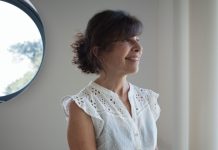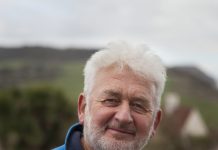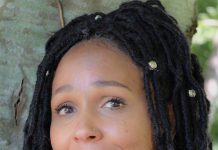Robin Mills went to Lyme Regis to meet artist David West. This is his story.
“I was born in 1939, in South London; the war had just started. I had a brother two years older, and a sister born a year after me. A second brother was born some fourteen years later. During the war I was sent to Bournemouth to live with my aunt, who was experiencing some difficulty in her marriage; the family felt she would benefit from having a young child to look after; so I was sent as a kind of sacrificial lamb. My aunt was very angry with her situation, and spent time stabbing the furniture with a knife, saying “I’ll kill him, I’ll kill him”. And then, when she was knocked off her bicycle by a goat and broke her leg, I couldn’t stop laughing, so I was sent back to London and the Blitz.
At a young age I believe I was clear about what I wanted to do. I can remember the paintings I did from when I was 5. My father, an interpreter during the war, ran away to Paris as a teenager in the 1920’s, living a life like George Orwell’s “Down and out in Paris and London”. I was about six or seven when I first saw my father; until then I had been brought up by my mother and grandmother. As a middle child I was often left on my own, and frequently I wandered off, later being brought home by the police. When my father suddenly returned home, I resented his discipline. My mother was very timid, with a passion for knitting. Neither showed any interest in art.
As a 15-year old, I hitch-hiked alone to Spain. I had saved £15 from a Saturday milk-round (with horse and cart), and made my way to Barcelona. I made friends with two anglophile brothers who ran a restaurant. There were very few tourists in 1954. I sketched the customers; some would buy me a meal in return, and after 3 months I came back still with £15 in my pocket. Maybe, my trip to Barcelona was an echo of my father’s independent spirit, his teenage escape to Paris.
I met Barbara at Camberwell School of Art; we were in the same year in the painting department. After leaving I started teaching part-time, but I found it stifling and uncreative. Barbara and I decided to go off to France, and then to Spain. We planned to get married in Madrid, but the ambassador at the Embassy got distracted by the Real Madrid football team and forgot about us. Eventually we married in Gibraltar, and spent a year painting in Andalusia.
When we came back to London I tried to paint on shapes that were not predetermined, and not confined by the rectangular. I soon found that canvas wasn’t suitable for this approach. I explored various ideas, such as sectional kites using cane, with muslin and paper. Most were made as large birds. I have always been interested in early ecclesiastic painting and furniture, so it seemed natural for me to paint on wood. I began to make simple miniatures of about 60 different regional styles of vernacular buildings, followed by more complicated architectural pieces, in the form of boxes, cupboards and small furniture. We were also restoring a house we had just bought.
When our daughter Esme was born in 1972, I gave up teaching, and lived on what we could earn as artists. Barbara taught part-time, whilst I looked after Esme. I made her lots of toys, including a doll’s house. A little later I was asked to make another. I went on to spend seven years making a miniature house and a series of carved “garden shelves” to surround it. The front was based on Eagle House, Mitcham, Surrey, a run-down Georgian house remembered from childhood. The interiors were based on different houses I had seen, some invented. The house stands about 8ft high. Ornately carved, very intricate and elaborately decorated, it opens on four sides. Whilst making it, I was able to develop many of my earlier ideas, and my woodworking skills. The house was exhibited at Fischer Fine Art, London in 1984, before going into a private collection.
We moved to Lyme Regis in 1981. Concerned about some local environmental issues, we actively opposed the dumping of nuclear waste in Lyme Bay, and a scheme to discharge untreated sewage into the sea at Lyme Regis. Later, I was involved with opposition to the development of the Town Mill site, owned by the town since 1343. A failed bid to develop the site privately, prompted the council to present a scheme to demolish and sell off bits of the medieval site. I was elected chairman of a small group opposed to the council’s plans, and invited key people with the necessary expertise to help, and put forward better solutions. Only two days before planning approval was expected, I successfully delayed a decision by asking for archaeological investigations. Concerts were held in various venues around the town to raise funds, some featuring Covent Garden singers. Among the many with responsibilities for the mill, we invited District Council chairman Mr Pengelly, and MP Jim Spicer. Both enjoyed opera, and both went on to help persuade the council that the trust was a credible body, and should henceforth deal with it in deciding the Mill’s future. Negotiations took three years. I chaired the Town Mill Trust for 10 years, standing down when the trust secured Lottery funding for the purchase of the house, and the restoration of the mill machinery. I devoted thousands of hours to the project, establishing the galleries and facilities for a wide spectrum of interests.
During this time I had touring exhibitions, undertook commissioned work, and taught occasionally at Parnham School of Cabinet Making. I ran summer workshops for visiting Japanese students. Later, I was selected by the students as the person they would most like to visit Japan. I ran summer workshops in different parts of the country for a number of years, and from the contacts I made I organized Japanese craftspeople to come to Dorset and see what people were doing here. That was followed by several Anglo-Japanese co-operative ventures, one of which was an astonishing exhibition in the Town Mill by a Japanese gossamer silk weaver from Okinawa, Michiko Uehara, which attracted 3000 visitors in the 7 days it was open.
In 2008 I was invited by the Sasakawa Foundation of Great Britain to spend a month in Japan, drawing. I chose to go to the Kii Penisular, a mountainous region, famous for a sacred path, ‘Kumano Kodo’, and the many temples and shrines. Mount Koya has 130 temples on it, and I stayed at one of the many which provide accommodation; then on to Yakushima Island in the south. The ancient yaku cedars, a type of cryptomeria, are very impressive—the oldest is said to be 7500 years old. The island was an extraordinary mixture of natural beauty and the bizarre. At 6 p.m. every evening the sound of Big Ben, followed by Scottish bagpipes, was heard coming from an avenue of palm trees, orchids growing in the crowns. A few of the trees had been replaced by brilliantly coloured plastic ones; deer and monkeys roamed about unaffected by the noise. After visiting my weaver friend on Okinawa, I returned with about 200 drawings and several illustrated journals.
On my return, I was commissioned to carve some organ pipe shades for St Michael’s Church in Lyme. I chose a marine theme for obvious reasons, using gold leaf and pierced carving, on a curved form, for the first time, and afterwards, I produced some gilded carvings and woodcut prints based on the sketches done in Japan.
For a number of years I have been asked to design gardens and structures. I spent a number of years working on the Belmont garden for John Fowles. I was also part of a small local group who re-designed the planting scheme for Langmoor and Lister Gardens. Gardens have always been very much part of my life. When we moved to Lyme, our new garden gave us the opportunity to create a garden together. There has never been any great plan, it has slowly evolved. So although Barbara and I continue to produce very different work, the garden has been a shared creation, with nature playing a large part. Very much like our art work.
Other projects have included extensions and the restoration of listed buildings, producing designs and scaled drawings, sometimes models. Not all obviously linked to art, but I like to think the experiences have somehow been channelled, and helped to enrich the work I do.”









